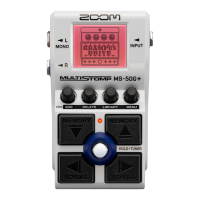
Do you have a question about the Zoom MULTISTOMP MS-50G+ and is the answer not in the manual?
| Brand | Zoom |
|---|---|
| Model | MULTISTOMP MS-50G+ |
| Category | Music Pedal |
| Language | English |
Stores effects, their order, states, and parameters; up to 100 can be stored.
A collection of guitar effects ready for use in patch memories.
Automatically saves changes to patch memories and effect settings.
Automatically turns off the unit after 10 hours of inactivity.
Allows continuous sound while switching to another patch memory.
Illustrates the path of the guitar signal through the device's components.
Details how effects are stored, ordered, and combined within patch memories.
Identifies and explains the display, jacks, knobs, buttons, and footswitches on the top.
Details the USB (Type-C) and DC 9V AC adapter ports for connectivity.
The main screen showing patch effects, allowing editing and toggling.
Displays effects for selection and replacement, showing selected effect and list.
The central hub for accessing all device settings and functions.
Adjusts tempo, reorders effects, and renames patch memories.
Manages patch memories through copying, saving, deleting, creating, and restoring.
Configures output volume, auto save, preselect, and library sound preview.
Adjusts battery type, display brightness/contrast, eco mode, and checks firmware.
Connects the guitar input and output to an amplifier.
Connects the AC adapter or USB for power supply.
Steps for powering on the device using batteries or an AC adapter.
Steps for safely powering down the device.
Details how changes to patch memories are saved automatically or manually.
Controls the active state of individual effects within a patch.
Substitutes an existing effect in a patch with a new one from the library.
Modifies settings like gain, tone, and mode for selected effects.
Inserts an additional effect into an existing patch memory.
Removes an effect from a patch memory.
Rearranges the order of effects in the signal chain.
Sets the tempo by repeatedly tapping a footswitch.
Adjusts the tempo numerically through the menu options.
Navigates through the available patch memories.
Activates or deactivates the preselect function.
How to choose the next patch memory when the preselect function is on.
Assigns custom names to patch memories for organization.
Duplicates or backs up patch memories to other memory locations.
Permanently deletes selected patch memories.
Generates blank patch memory slots for new configurations.
Reverts a patch memory to a previous state or factory defaults.
Steps to engage the tuner to tune a guitar.
Configures tuner output as BYPASS or MUTE.
Changes the reference frequency for tuning.
Chooses between chromatic and various alternate tuning modes.
Enables tuning strings flat by one, two, or three semitones.
Controls the MS-50G+ using the Handy Guitar Lab app.
Sets the master volume for the entire unit.
Determines if patch changes are saved automatically.
Chooses between single effect or full patch preview in the library.
Selects battery chemistry for precise charge monitoring.
Controls the screen's backlight intensity for visibility or battery saving.
Modifies the contrast level of the LCD display.
Enables automatic power-off to conserve battery.
Displays the current firmware and bootloader versions.
Instructions for installing the latest firmware version.
Resets all user settings and patch memories to factory state.
Provides a QR code linking to online help documentation.
Solutions for issues preventing the unit from powering up.
Troubleshooting steps for audio signal problems.
Addresses causes and solutions for unwanted noise.
Tips to extend battery life and resolve rapid drain.
